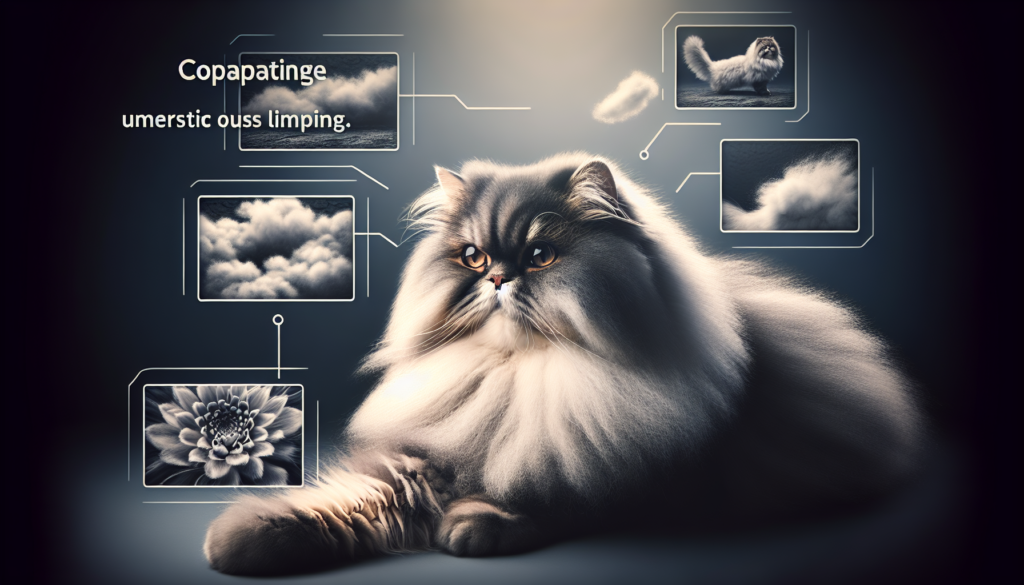Have you ever wondered why Persian cats have a tendency to go limp when you hold them? In this article, we will explore the fascinating reason behind this peculiar behavior of our fluffy feline friends. Persian cats, known for their luxurious coats and striking beauty, have developed an interesting reaction to being picked up or handled. It is as if their bodies instantly relax, causing them to go limp in your arms. So, why do Persians go limp? Let’s find out the surprising answer behind this endearing trait exhibited by these majestic creatures.
Characteristics of Persian Cats
Physical appearance
Persian cats are known for their stunning and distinct physical appearance. They have long, luxurious coats that come in a variety of colors, including white, black, blue, and cream. Their round faces, expressive eyes, and small, flat noses give them an adorable, doll-like appearance. Persian cats also have a sturdy build with short, stocky legs and a wide, short neck.
Temperament
When it comes to temperament, Persian cats are known for their calm and gentle nature. These cats have a laid-back demeanor and enjoy a relaxed and peaceful environment. They are typically reserved and tend to be less active compared to other cat breeds. Persian cats are generally friendly and make wonderful companions, as they thrive on attention and affection.
Health concerns
While Persian cats are generally healthy, they are prone to certain health concerns. One common issue is their high susceptibility to respiratory problems due to their facial structure. The short nose and flat face of Persian cats can lead to breathing difficulties, especially during hot weather or exercise. Additionally, their long and dense coats require regular grooming to prevent matting and skin problems. Persian cats also have a higher risk of developing polycystic kidney disease, a hereditary condition that affects their kidney function.
Understanding the Limping Behavior
Overview of limping in cats
Limping refers to an abnormality in a cat’s gait, where they exhibit a noticeable change in their walking pattern or favor one leg over the others. Limping can be caused by various factors, including injury, pain, or an underlying medical condition. It is essential to understand the potential reasons why Persian cats may experience episodes of limping.
Possible reasons for Persian cats going limp
There are several factors at play when it comes to Persian cats going limp. These can be broadly categorized into physical, environmental, and psychological factors that contribute to the development of limping behavior.

Physical Factors
Genetic predisposition
Genetic predisposition plays a significant role in the development of limping behavior in Persian cats. Due to selective breeding practices, certain genetic traits associated with this breed can contribute to orthopedic issues, such as hip dysplasia or luxating patella. These conditions can cause discomfort and result in limping episodes.
Physical attributes
The physical attributes of Persian cats can also contribute to their susceptibility to limping. Their short legs, compact body structure, and excessive facial skin folds may increase the chances of musculoskeletal problems. These physical attributes can put additional stress on their joints and potentially lead to limping.
Obesity
Obesity is a common concern among Persian cats and can significantly impact their overall health. Being overweight puts extra strain on their joints and muscles, increasing the likelihood of limping behavior. Maintaining a healthy weight through a balanced diet and regular exercise is crucial for preventing obesity-related limping problems.
Environmental Factors
Temperature sensitivity
Persian cats are known to be sensitive to temperature changes, particularly extreme heat. Hot weather can cause discomfort and lead to swelling or inflammation in their joints, resulting in limping behavior. It is important to provide them with a cool and well-ventilated environment to minimize the risk of heat-related limping.
Home environment
The home environment plays a crucial role in the overall well-being of Persian cats. An unstimulating or stressful environment can contribute to anxiety and stress, potentially leading to limping behavior. Creating a calm and enriched living space with plenty of hiding spots, comfortable resting areas, and stimulating toys can help prevent stress-related limping episodes.
Noise sensitivity
Persian cats, like many other feline breeds, can be sensitive to loud noises or sudden sounds. Exposure to excessive noise levels can trigger anxiety and stress, causing Persian cats to exhibit limping behavior as a response to their heightened emotional state. Minimizing loud noises or providing a quiet sanctuary for them can help alleviate this issue.

Psychological Factors
Anxiety and stress
Psychological factors, such as anxiety and stress, can have a profound impact on a Persian cat’s overall well-being. Cats are sensitive animals, and changes in their environment or routine can lead to feelings of anxiety or stress, which may manifest as limping behavior. Understanding and addressing the underlying causes of anxiety or stress can help prevent or manage limping episodes.
Bonding and trust
Establishing a strong bond and building trust with a Persian cat is crucial for their mental and emotional well-being. Persian cats thrive in a stable and supportive environment where they feel safe and secure. Lacking proper socialization or experiencing a breakdown in trust can result in anxiety, stress, and potentially limping behavior.
Previous traumas
Previous traumatic experiences, such as accidents or injuries, can have long-lasting effects on a Persian cat’s behavior and physical health. Cats with a history of trauma may exhibit limping as a result of the lingering effects of past injuries. Providing appropriate care, support, and a stress-free environment can help these cats overcome their past traumas and reduce the occurrence of limping episodes.
Frequency and Duration of Limping
Intermittent limping
Limping in Persian cats can occur intermittently, meaning it comes and goes. These episodes of limping may be triggered by specific circumstances, such as environmental factors or increased physical activity. Intermittent limping can be a sign of a temporary issue or discomfort that resolves on its own.
Chronic and persistent limping
In some cases, Persian cats may exhibit chronic or persistent limping, where the limping behavior persists over an extended period. Chronic limping can be indicative of a more serious underlying condition, such as arthritis or joint degeneration, and requires prompt veterinary attention.
Frequency of episodes
The frequency of limping episodes can vary from one Persian cat to another. Some cats may experience limping infrequently, while others may have more regular occurrences. Monitoring the frequency and timing of limping episodes can help identify potential triggers or patterns and guide appropriate preventive measures or treatment.
Diagnosing Limping in Persian Cats
Observation and documentation
When a Persian cat exhibits limping behavior, it is crucial to observe and document their symptoms and behaviors. Note down the frequency, duration, and any potential triggers for the limping episodes. This information will be valuable for your veterinarian in diagnosing and determining the appropriate course of action.
Physical examination
A thorough physical examination is essential to assess the overall health and condition of the Persian cat. The veterinarian will examine the affected limbs, joints, and muscles for any signs of injury or inflammation. They may also conduct range-of-motion tests to evaluate the cat’s mobility and assess any pain or discomfort.
Diagnostic tests
In some cases, additional diagnostic tests may be necessary to identify the underlying cause of the limping behavior. These tests may include X-rays, blood tests, or joint fluid analysis to evaluate for conditions such as arthritis, fractures, or infections. These diagnostic tools can provide valuable insights into the cat’s condition and guide appropriate treatment options.
Preventive Measures
Maintaining a healthy weight
Obesity is a significant risk factor for limping in Persian cats. To prevent obesity-related limping issues, it is important to maintain a healthy weight for your cat. This can be achieved through a balanced diet, portion control, and regular exercise. Consulting with your veterinarian on appropriate feeding recommendations and exercise routines specific to your cat’s needs is essential.
Creating a suitable home environment
Creating a suitable home environment is crucial for the overall well-being of Persian cats. Ensure your home provides a comfortable, stress-free, and enriched environment to minimize anxiety and stress-related limping behaviors. This includes providing suitable resting areas, interactive toys, and a calming atmosphere. Avoiding excessive noise and providing adequate hiding spots can also help alleviate stress.
Ensuring regular veterinary check-ups
Regular veterinary check-ups are vital for monitoring the overall health and well-being of Persian cats. Routine examinations can help detect any potential health issues early on, including those that may contribute to limping behavior. Your veterinarian can provide preventive care recommendations tailored to your cat’s specific needs, including vaccinations, parasite control, and ongoing monitoring of any pre-existing conditions.
Managing Limping Episodes
Massage and gentle stretching
During limping episodes, providing gentle massage and stretching exercises can help alleviate muscle tension and improve joint mobility. Seek guidance from your veterinarian on appropriate techniques and precautions to ensure you do not exacerbate any underlying conditions. These interventions can provide temporary relief and support your cat’s overall comfort.
Creating a calming environment
Creating a calming environment during limping episodes can help minimize stress and anxiety in Persian cats. Provide your cat with a quiet and secluded space where they can rest and recover. Reduce exposure to loud noises and create a soothing atmosphere by using soft lighting, calming music, or pheromone diffusers.
Utilizing pheromone products
Pheromone products, such as synthetic pheromone sprays or diffusers, can help create a calming environment for Persian cats. These products mimic the natural pheromones that cats release when they feel safe and secure. By utilizing pheromone products, you can help reduce anxiety and stress-related limping episodes.
Seeking Veterinary Advice
When to consult a veterinarian
It is important to consult a veterinarian if your Persian cat is experiencing limping episodes. While occasional limping may resolve on its own, persistent or worsening limping can indicate underlying health issues requiring medical attention. Additionally, if your cat shows signs of severe pain, reluctance to move, or loss of appetite, prompt veterinary intervention is necessary.
Possible treatments and therapies
Depending on the underlying cause of the limping behavior, treatment options may vary. Your veterinarian may prescribe medications to alleviate pain and inflammation, recommend dietary changes, or offer physical therapy. In more severe cases, surgical intervention may be necessary to address orthopedic issues. The appropriate treatment plan will be determined based on the specific needs and condition of your Persian cat.
Monitoring overall health
After seeking veterinary advice and implementing a treatment plan, it is crucial to monitor your Persian cat’s overall health and well-being. Regularly observe and assess their gait, mobility, and behavior to ensure they are responding positively to treatment. Communicate any changes or concerns to your veterinarian to ensure ongoing management and maintenance of your cat’s health and comfort.
In conclusion, Persian cats are beautiful and gentle creatures that may experience limping behavior due to various physical, environmental, and psychological factors. Understanding these factors, seeking veterinary advice when necessary, and providing appropriate preventive measures and care can ensure the well-being and comfort of these magnificent feline companions. Remember to monitor your Persian cat’s health closely and create a nurturing environment to keep them happy and thriving.
